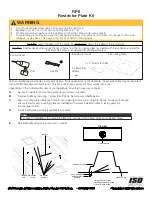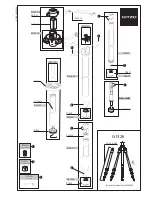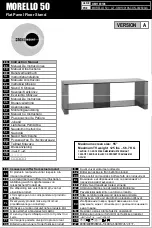KAC−12040
www.onsemi.com
16
•
The integration time is varied until the integration time
required to reach the 70% saturation is determined.
M
AVG
= the active array mean at the 70% saturation
integration time.
•
The integration is set to 1/14 (5% exposure point).
L
AVG
= meant at the 5% exposure point.
•
PRNL (@ 5% saturation) = ((L
AVG
/M
AVG
)
⋅
(14/1) −1)
⋅
100
12) Maximum Gain Difference between Outputs
The sensor contains two ADC and four channels of analog
data in its highest frame rate configuration. The sensor is
factory calibrated to reduce the gain differences between the
channels. The gain variations are manifest as a row oriented
pattern where every other row uses a different ADC. Using
triple scan read out mode, an additional two analog channels
are introduced resulting in a four row pattern. With one
channel (‘Top Ping’) used as the reference, the residual gain
difference is defined as:
ǒ
Bottom Ping Row Average
Top Ping Row Average
*
1
Ǔ
@
100
ǒ
Top Pong Row Average
Top Ping Row Average
*
1
Ǔ
@
100
ǒ
Bottom Pong Row Average
Top Ping Row Average
*
1
Ǔ
@
100
13) Photodiode Dark Current
The photodiode dark current is measured in rolling shutter
read out mode using 105 ms integration time and an analog
gain = 8. The value is converted to electrons/pix/sec using
the formula:
Photodiode Dark Current
+
Aver. Signal (DN)
@
el−per−DN (gain=8)
0.105 seconds
where ‘average signal (DN)’ is the average of all pixels in
the sensor array, and ‘el-per-DN (gain=8)’ is measured on
each sensor using the photon transfer method.
14) Storage Node Dark Current
The storage node dark current is measured in global
shutter read out mode using a special timing mode to prevent
the photodiode dark current from being transferred to the
storage node. In global shutter mode, the integration time of
the storage node is the time it takes to read out a frame. The
sensor analog gain is set to 2:
Storage Node Dark Current
+
Aver. Signal (DN)
@
el−per−DN
(gain=2)
0.138 seconds
where ‘average signal (DN)’ is the average of all pixels in
the sensor array and ‘el-per-DN (gain=2)’ is measured on
each sensor using the photon transfer method.
15) Lag
Lag is measured as the number of electrons left in the
photodiode after readout when the sensor is illuminated at
70% of Photodiode Charge Capacity.
Analog gain is set to 8. With no illumination a 64 average
dark image is recorded (Dark_ref). The ‘el-per-DN’ is
measured using the photon transfer method.
Illumination is adjusted blink every other frame such that
the mean image output is 70% of the Photodiode Charge
Capacity for even frames, and with no illumination for odd
frames. A 64 frame average of Odd Dark Frames is recorded
as Dark_Lag.
Lag
+
(
Dark_Lag
*
Dark_Ref
)
@
el−per−DN
Units : Electrons rms
16) Photodiode Charge Capacity
The sensor analog gain is reduced to < 1 to prevent ADC
clipping at 1023 dn. The ‘el-per-DN’ is measured using the
photon transfer method. The sensor is illuminated at a light
level ~1.5x the illumination at which the pixel output no
longer linearly changes with illumination level.
The Photodiode Charge Capacity is equal to the average
signal (DN)
⋅
el-per-DN. Units: electrons rms.
17) Dark Field Faint Column/Row Defect
A 4 frame average, no illumination image is acquired at
one line time of integration. Major defective pixels are
removed (> 5 Sigma). All columns or rows are averaged
together. The average of the local ROI of 128 columns or
rows about the column/row being tested is determined. Any
columns/rows greater than the local average by more than
the threshold are identified.
18) Bright Field Faint Column/Row Defect
A 4 frame average, 70% illumination image is acquired at
one line time of integration. Major defective pixels are
removed (> 5 Sigma). All columns or rows are averaged
together. The average of the local ROI of 128 columns or
rows about the column/row being tested is determined. Any
columns/rows greater than the local average by more than
the threshold are identified.
19) Total Pixelized Noise
This test is performed with no illumination and one line of
integration time. A single image is captured including both
Temporal and Fixed Pattern Noise (FPN). A spatial low pass
filter is applied to remove shading and deviant pixels
(
±
three standard deviations) are removed. The Total
Pixelized Noise is defined as one standard deviation of the
frequency histogram.
20) Responsivity ke
−
/lux-sec
This number is calculated by integrating the
multiplication of the sensor QE by the human photopic
response assuming a 3200K light source with a QT100 IR
filter. This is a sharp 650 nm cutoff filter. If the IR filter is
removed a higher response value will result.
21) Responsivity V/lux-sec
Voltage levels are not output from the sensor. This metric
uses the pixel output in volts at the ADC input for 1x Analog
Gain.


















